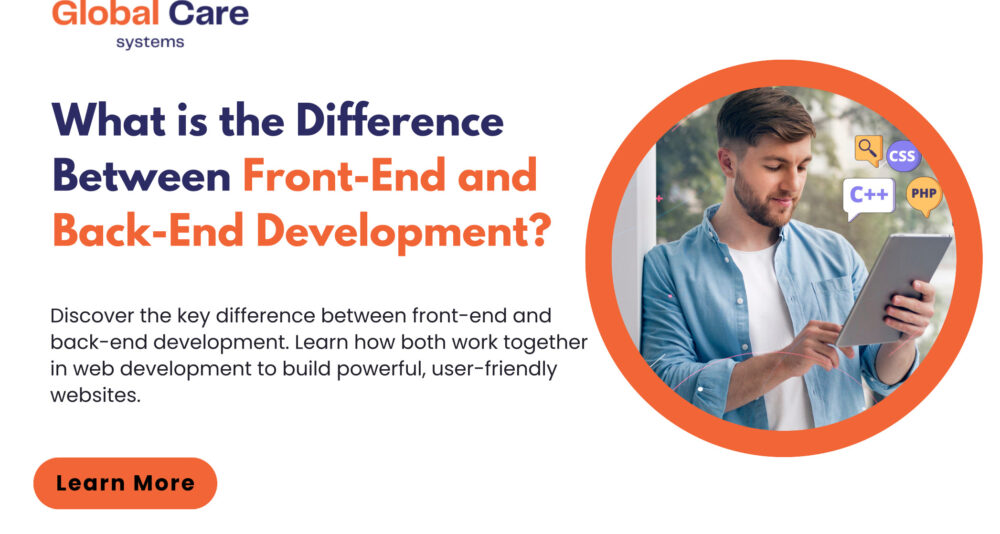In the digital era, every website and application we use daily is the result of careful planning, design, and coding. When people discuss building sites, the terms “front-end” and “back-end” frequently arise. Both are essential aspects of web development, yet they focus on different parts of how a website looks, functions, and delivers information to users. Understanding their differences is
crucial not only for aspiring developers but also for businesses hiring professionals to create or maintain their online platforms.This blog will break down the differences between front-end and back-end development, their respective roles, the tools and skills required, and how they work together to build seamless digital experiences.
What is Front-End Development?
Front-end development, often referred to as the client-side, is everything users see and interact with directly in their browser or app. The front end determines how a website looks, feels, and responds to user actions.
Key Elements of Front-End Development:
- User Interface (UI): The layout, buttons, menus, and design elements users see on the screen.
- Responsiveness: Ensuring websites adapt well to desktops, tablets, and mobile devices.
- Performance: Optimizing speed so users can access pages quickly without delays.
- Accessibility: Designing sites so people with disabilities can use them effectively.
Standard Front-End Languages and Tools:
- HTML (HyperText Markup Language): Structures content on the page.
- CSS (Cascading Style Sheets): Styles the look and layout.
- JavaScript: Adds interactivity, such as sliders, forms, and animations.
- Frameworks like React, Angular, and Vue.js speed up development with reusable components.
Role of a Front-End Developer:
Front-end developers bridge the gap between design and technology. They translate mockups and wireframes into fully functional websites while ensuring usability, accessibility, and cross-browser compatibility.
What is Back-End Development?
Back-end development, or the server-side, is the part users never directly see. It powers the front-end experience by handling databases, servers, and application logic. If the front end is the face of a website, the back end is its brain.
Key Elements of Back-End Development:
- Databases: Store user information, product catalogs, and content (e.g., MySQL, PostgreSQL, MongoDB).
- Server-Side Logic: Processes user requests, including login, checkout, and data retrieval.
- Authentication & Security: Ensures user accounts and sensitive data are protected.
- APIs (Application Programming Interfaces): Enable communication between front-end and back-end systems.
Common Back-End Languages and Tools:
- Programming Languages: PHP, Python, Java, Ruby, C#, Node.js.
- Frameworks: Django, Laravel, Spring Boot, Express.js.
- Servers: Apache, Nginx.
- Databases: MySQL, MongoDB, Oracle.
Role of a Back-End Developer:
Back-end developers build and maintain the systems that process user data and power the front end. They make sure applications are reliable, secure, and scalable.
The Key Differences Between Front-End and Back-End Development
1. Focus Area
- Front-End: Deals with everything users interact with — visuals, layout, and functionality.
- Back-End: Handles behind-the-scenes logic, data processing, and system architecture.
2. User Interaction
- Front-end: Focuses on delivering an engaging and intuitive user experience.
- Back-End: Focuses on ensuring data flows securely and accurately.
3. Technologies Used
- Front-End: HTML, CSS, JavaScript, React, Vue, Angular.
- Back-End: Java, Python, PHP, Node.js, Ruby, C#, databases.
4. Performance Impact
- Front-End: Impacts page load times, responsiveness, and usability.
- Back-End: Impacts server response times, data security, and scalability.
5. End Goal
- Front-End: Make the website look appealing and user-friendly.
- Back-End: Make sure the website functions smoothly and securely.
How Front-End and Back-End Work Together
Think of a website as a restaurant:
- The front-end is like the dining area — the menu, tables, and ambiance that customers experience.
- The back-end is like the kitchen — it’s where chefs, storage, and recipes come together to prepare the food.
When a user clicks “Order Now,” the request is sent to the back end, where it is processed, the database is checked, and the result is sent back to the front end, which displays the confirmation.
This collaboration ensures a seamless and complete user experience.
Skills Required for Front-End vs. Back-End Developers
Front-End Developer Skills:
- Proficiency in HTML, CSS, and JavaScript.
- Knowledge of frameworks like React or Angular.
- Understanding of UX/UI design principles.
- Testing and debugging skills.
- SEO basics for web performance optimization.
Back-End Developer Skills:
- Mastery of server-side languages (PHP, Python, Java, Node.js).
- Strong knowledge of databases.
- Understanding of API design and integration.
- Security best practices.
- Cloud services (AWS, Azure, Google Cloud).
Career Opportunities in Front-End and Back-End
Front-End Developer Roles:
- UI/UX Developer
- Web Designer/Developer
- Front-End Engineer
- Mobile App Interface Developer
Back-End Developer Roles:
- Database Administrator
- Software Engineer
- API Developer
- System Architect
Both front-end and back-end developers are in high demand across IT companies, startups, e-commerce platforms, and tech giants across the globe.
Salary Expectations
- Front-End Developers: Entry-level salaries in India range from ₹4 LPA to ₹6 LPA, with experienced developers earning ₹12 LPA or more.
- Back-End Developers: Usually slightly higher at entry level — ₹5 LPA to ₹8 LPA, with senior roles exceeding ₹15 LPA+.
Globally, both skill sets are highly valued, with back-end developers often earning a premium due to the complexity of server-side systems.
Should You Choose Front-End or Back-End Development?
Choose Front-End if:
- You enjoy creativity, design, and visual interaction.
- You should focus on the user experience.
- You are detail-oriented when it comes to layouts and responsiveness.
Choose Back-End if:
- You enjoy problem-solving and logic.
- You like working with databases and algorithms.
- You prefer focusing on functionality rather than visuals.
Some professionals even pursue full-stack development, which combines both skills, making them versatile in the job market.
The Rise of Full-Stack Development
A Full-Stack Developer is skilled in both front-end and back-end development. They can design user interfaces, build server-side logic, and integrate databases.
Benefits of Full-Stack Development:
- Flexibility in projects.
- Higher salary potential.
- Strong demand in startups where developers wear multiple hats.
Popular full-stack stacks include:
- MEAN (MongoDB, Express.js, Angular, Node.js)
- MERN (MongoDB, Express.js, React, Node.js)
- LAMP (Linux, Apache, MySQL, PHP)
Final Thoughts
Front-end and back-end development are two sides of the same coin in web development. While front-end developers focus on the look and feel, back-end developers ensure functionality, security, and efficiency. For businesses, a strong front-end attracts users, while a powerful back-end keeps them satisfied.
For students and professionals, the choice between front-end and back-end depends on whether you prefer creativity and visuals or logic and data. And if you’re ambitious, becoming a full-stack developer can give you the best of both worlds.
In 2025 and beyond, demand for both roles will continue to grow as businesses expand their digital presence. Whether you choose front-end, back-end, or full-stack, one thing is for sure—your skills will continue to be extremely valuable in the evolving digital economy.

